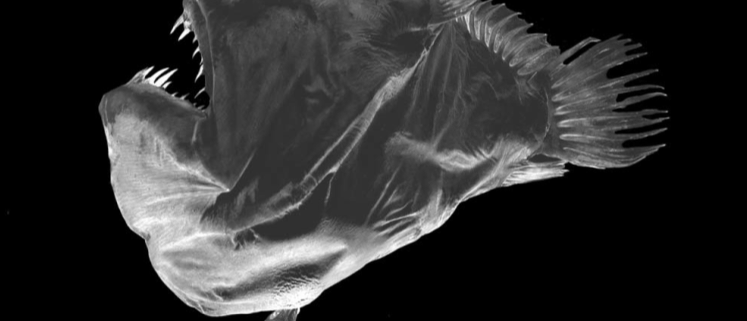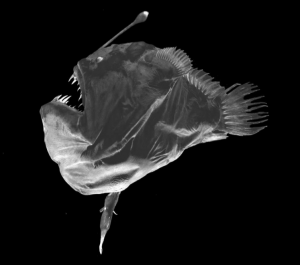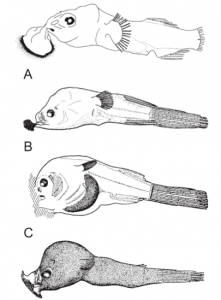Reproduction in the deep sea
by Megan Piechowski, RJD Intern
Have you ever wondered how small, sparsely populated fish find each other to mate in the deep, dark ocean? Due to the unusual light organ that is found dangling over the mouth of a certain deep-sea creature it is likely one of the most well-known and recognizable fish that dwells in the deep sea (Picture 1). These fish were discovered ninety years ago and have been studied extensively due to their use of an extremely unique and successful reproduction strategy. Over sixty years ago this discovery remained unfathomable to many. The first scientist to descend into the deep abyss, William Beebe, likely faced much disbelief about these unknown organisms:
“To be driven by impelling odor headlong upon a mate so gigantic, in such immerse and forbidding darkness, and willfully to eat a hole in her soft side, to feel the gradually increasing transfusion of her blood through one’s veins, to lose everything that marked one as other than a worm, to become a brainless, senseless thing that was a fish – this is sheer fiction, beyond all belief unless we have seen the proof of it.”
This deep-sea resident is classification in the suborder Ceratioidei, a division of the order commonly referred to as anglerfish. The anglerfish in Ceratioidei provide a major contribution to the biodiversity of the deep-sea as a primary carnivore in their communities. Due to the difficulties they face finding a mate in their environment these fish have gone to extremes to guarantee successful reproduction upon the discovery of the opposite sex. This group of anglerfish has adapted a strategy allowing the dwarfed males to attach to the females, either temporarily or permanently (Mead). The combination of this drastic size difference and the presence of the female-only light organ demonstrate exceptional sexual dimorphism (Pietsch).
Male anglerfish are one of the smallest known vertebrates and possess large eyes and nostrils, which are instrumental to locate a female emitting species-specific pheromones. The most extreme example of the enormous size difference is found in the species Ceratias holboelli, where the females are half a million times heavier than the males (Pietsch, Orr). This drastic size difference is crucial to the relationship between male and female to minimize the impact to the female once they are attached. However, the process of attachment entails a series of drastic morphological changes to the male. He is able to better latch onto the female’s body by replacing the normal jaw teeth with the development of a pair of pincer-like denticles at the ends of his jaw (Pietsch). In many species the male permanently attaches to the female and becomes a parasite. The outgrowths used to hold onto the female eventually fuse with her skin (Picture 2).
Ultimately, this allows the male to accesses the female’s circulatory system where he is able to survive by removing nutrients from her blood. This relationship creates a situation where the “female appears as a kind of self-fertilizing hermaphrodite”, and the male is been reduced to an organ with a single function of producing sperm (Mead).
This parasitic relationship creates a beneficial situation for both sexes. While the female must feed more frequently to account for the male removing nutrients, she is guaranteed a lifetime of successful spawning seasons. Each season she will produce a large quantity of small eggs, where it is hypothesized that the same male is responsible for fertilizing each season of spawning until the female dies. The permanent attachment allows for an economic use of the small amount of semen present in the dwarfed male. Due to the miniscule size of male anglerfish this relationship benefits him as a source of protection from predators and a free food source (Mead).
Once the pair has successfully reproduced and released fertilized eggs the young spend the majority of their larval development in the epipelagic waters, rarely found below two hundred meters. This is beneficial to the larvae as this zone in the ocean is much more productive and contains more nutrients than the depths where they will spend the rest of their lives. As the young mature their sex typically determines where they are found within the water column. All of the young anglerfish tend to sink to depths between one and three thousand meters, where females are typically distributed in the deeper end of that range (Mead).
Surprisingly, scientists like William Beebe already knew much of the strategies used by these fish. However, recent genetic analysis has shined a light on the dark and bizarre history and distribution of anglerfish. Their parasitic relationship proves to be a successful method of reproduction for these deep-sea creatures as it is understandably difficult to locate a member of the opposite sex every spawning season at two thousand meters. Much of the deep sea has yet to be explored and there are likely many more unfathomable species with extreme survival adaptations that will inspire future generations of marine biologists to explore the depths of our oceans for answers.
REFERENCES
Mead, Giles W., E. Bertelsen, and Daniel M. Cohen. “Deep Sea Research and Oceanographic Abstracts.” SciVerse 11.4 (1964): 569-96. http://iiiprxy.library.miami.edu:2172/science/article/pii/0011747164900038#. Web. 17 Feb. 2013.
Pietsch, Theodore W. “Dimorphism, Parasitism, and Sex Revisited: Modes of Reproduction among Deep-sea Ceratioid Anglerfishes (Teleostei: Lophiiformes).” Ichthyological Research (2005): 207-36. ProQuest. Web. 17 Feb. 2013. <http://search.proquest.com/docview/821813922>.
Pietsch, Theodore W., and James W. Orr. “Phylogenetic Relationships of Deep-Sea Anglerfishes of the Suborder Ceratioidei (Teleostei: Lophiiformes) Based on Morphology.” Copeia 2007 (2007): n. pag. JSTOR. American Society of Ichthyologists and Herpetologists (ASIH), 28 Feb. 2007. Web. 17 Feb. 2013.






Leave a Reply
Want to join the discussion?Feel free to contribute!